Special fossils deserve special attention. The Paläontologische Gesellschaft therefore honors a very special fossil each year with the title Fossil of the Year – In 2023, it is Medullosa stellata
Fossils are unique testimonies of the development of life on our planet. They provide us with evidence of often dramatic changes in the environment and living conditions over unimaginably long periods of time. They vividly show how the present diversity of organisms developed in the course of evolution and also document life forms that no longer exist today. Fossils are of great practical use, for example in the exploration of raw materials or in climate research, but they are always special objects of scientific knowledge.
This year, strictly speaking, there are two fossils, but they belong to one and the same organism – the fossil plant Medullosa stellata with attached fronds of the type Alethopteris schneideri. It belongs to the now extinct group of seed ferns and thrived in seasonally dry tropical forests in the early Permian, about 290 million years ago.
Medullosa stellata was first described by Bernhard von Cotta in 1832, but to this day relatively little is known about this group of ancient seed plants, which is hardly comparable with today's plants. The medullosales resemble today's tree ferns in their growth form and foliage. However, they are hardly related to ferns, since they reproduced by seeds rather than spores. They are probably most closely related to the cycads, of which there are still living representatives today.
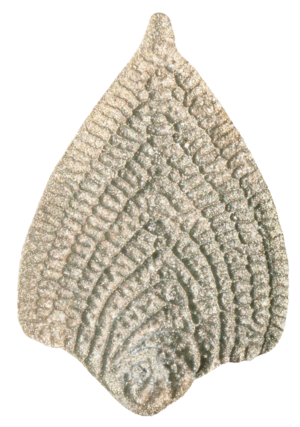
Since the Fossil of the Year was first awarded in 2008, this is the first time a microfossil has received the title. Microfossils are so small that their identification and examination require a microscope. Because of their small size, microfossils are not nearly as well known among the general public as, for example, dinosaurs or ammonites, but they are very useful guide fossils and indicators of the environmental conditions of the geological past, partly because they can occur in large numbers in smaller samples, such as those obtained by drilling. The foraminifer Neoflabellina reticulata selected this year has a beautifully ornamented, characteristic shell and is also an important biostratigraphic guide form. Such guide forms allow precise age classification of rock strata in which they occur.
A characteristic foraminifera of the Cretaceous sea
Neoflabellina reticulata is a typical foraminifera of the Cretaceous sea. The Schreibkreide, as the chalk rock is known in German, is a soft and very pure limestone composed primarily of minute pieces of calcareous algae that was deposited in shelf seas in much of Europe and North America during the Upper Cretaceous hothouse world. The fossil-rich Cretaceous also contains several hundred species of foraminifera in Central Europe.
Foraminifera are single-celled organisms that can form a shell that is usually made of calcite or composed of sediment particles. They live mainly in the oceans, where they are found in large numbers in all water depths. Although some species grow up to 15 cm - a remarkable size for unicellular organisms - most are smaller than 1 mm. Neoflabellina reticulata with a length of almost 2 mm belongs to the larger foraminifera. Its strongly flattened and lanceolate shell consists of numerous chambers, which are arranged spirally in the first developmental stages and then correspond to the type of riding chambers, i.e. the chambers embrace about 180° of the shell circumference and follow each other. This is reflected by the ribs of the ornamentation, although somewhat hidden by smaller transverse ribs. The mouth of the interconnected chambers is at the top of the case. The case is made of calcite and has fine pores.
Austrian physician and paleontologist August Emanuel Reuss described Neoflabellina reticulata from the Cretaceous marls of Lemberg in Galicia (now Lviv in western Ukraine). Reuss made his main contribution to the study of foraminifera.
When, where and how did Neoflabellina reticulata live?
Neoflabellina reticulata was a cosmopolitan species. It is restricted to the Maastrichtian, the last stage of the Cretaceous, ending with the great extinction event that also killed the dinosaurs. Neoflabellina reticulata occurred only in deeper waters of the shelves below the base of storm waves because its shell is very fragile. It appears to have endured variable water temperatures.
The significance of Neoflabellina reticulata
The significance of this year's Fossil of the Year lies in its biostratigraphic leading value for the Maastrichtian in the uppermost Upper Cretaceous and its indicator value for the shelf below the storm wave base. In terms of scientific history, Neoflabellina reticulata is one of the first foraminifera species described from the Cretaceous and its description coincides with the founding period of micropaleontology as a scientific discipline. The aesthetic appeal of the genus Neoflabellina found expression in the sale of enlarged models as jewelry pendants in the Paleontological Museum of Paris.
Where can you see Neoflabellina reticulata?
Because of their small size, microfossils are not usually shown in exhibitions, but can be found in the paleontological collections of museums. This is also true for Neoflabellina reticulata - the Reuss material was deposited at the Natural History Museum Vienna. Other illustration originals are kept for example at the Museum für Naturkunde zu Berlin, in the collections of the Bundesanstalt für Geologie und Rohstoffe in Hannover and paleontology institutes at the universities in Kiel and Greifswald. A virtual exhibition with many foraminifera of the Cretaceous can be viewed for example at www.foraminifera.eu - Neoflabellina reticulata is also represented there. To obtain this foraminifera even from writing chalk sediment of the Maastrichtian, it has to be disintegrated and carefully sieved. Because of the size of Neoflabellina reticulata, a large sediment volume and a sieve of mesh size 0.5 mm is recommended.
Peter Frenzel & Anna Pint (Jena), Micropaleontology Working Group
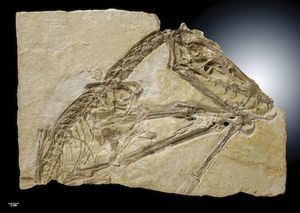
The Fossil of the Year 2021 is the Upper Jurassic pterosaur Scaphognathus crassirostris from the 150 million year old Solnhofen Plattenkalk Limestone in southern Germany.
The pterosaur Scaphognathus crassirostris marked the beginning of a development that makes dinosaurs generally known today. The professor of zoology and paleontology Georg August Goldfuß (1782-1848) from the University of Bonn examined the fossil in detail and developed an idea of the pterosaur's mode of life. Goldfuß, a pioneer of paleontology, then had a revolutionary drawing made on the basis of this skeleton. It was one of the first to depict a long-extinct animal alive and in its own habitat. No one before had dared to publish such artwork scientifically and with an explanation for their reconstruction. Nevertheless, Goldfuß added the drawing to his description of the pterosaur in 1831.
Only three specimens of this rare pterosaur species are known to science. They come from the Late Jurassic limesteon in the Franconian Alb, namely from the area around Solnhofen and Eichstätt.
The skeleton of the first description was exhibited by Georg August Goldfuß in the Natural History Museum of the University of Bonn. The fossil collection of this museum bears his name today and is celebrating its 200th anniversary as the Goldfuß Museum, having opened at the beginning of the summer semester in 1821. On this occasion, the fossil is being presented in the exhibition for the first time again after several loans.
Other original fossils of this kind are kept at the Museum am Löwentor in Stuttgart and at the Fossilien- und Steindruck-Museum in Gunzenhausen. Goldfuß sent casts of the Bonn specimen to numerous museums in Europe as early as the 19th century. Even in the Oxford University Museum of Natural History and the Texas Memorial Museum in Austin, casts of this piece are part of the permanent exhibition.
Goldfuß examined the skeleton in detail after preparing it himself. He discovered a kind of hair coat on the animal and described how very different the physique of this extinct animal was from all modern animals. Nevertheless, he developed an idea of the pterosaur's way of life as an active flyer. He had the university art teacher Christian Hohe depict the animal in several lithographs and color the prints elaborately by hand. The illustration of two living Scaphognathus specimens with skin and hair in flight and on a cliff impressively brought out Goldfuß's assumptions about the animal's way of life. From then on, research began to take images of living dinosaurs seriously and to use them scientifically. Reconstructions of fossils as living organisms are now widespread in research and media as paleo-art. They inspire many people and have greatly contributed to the spread of scientific knowledge about fossils. The origins of today's dinosaur films, cartoons and characters can therefore be found in this fossil and its scientific interpretation.
Scaphognathus crassirostris was the first pterosaur in which a type of hair coat was found. Goldfuß described it as early as 1831 in the neck area and on the wing membranes. But these were not hairs as we have them, which is why current research calls them "pycnofibres". The body covering indicates that the pterosaurs were warm-blooded just like birds and mammals. This fits the picture because pterosaurs like Scaphognathus were the first active flyers among vertebrates and birds and mammals are also warm-blooded. Unlike birds, they did not fly with feathers, but lifted themselves into the air with wing membranes similar to today's bats. On Goldfuß's specimen, remains of the membranes are preserved down to the smallest detail. The fact that active flight developed independently in pterosaurs, bats and birds without any close relationship is a prime example of convergent evolution.
For a pterosaur of its wingspan, Scaphognathus crassirostris has a particularly large skull with strong jaws. This is also the origin of its name, which means "thick beak". With its robust jaws, it probably hunted fish and insects. All these findings, which are still valid today, can already be found in Goldfuß's publication, with the exception of the warm-bloodedness, which he hinted at.
Scaphognathus comes from the same upper Jurassic strata as Archaeopteryx. It is a long-tailed pterosaur, a group which became extinct a short time later, while birds and short-tailed pterosaurs spread.
When scientific explanations contradict each other, this is often presented as a dispute between scientists. But it is part of scientific progress that existing assumptions have to be corrected in the light of new findings. This is what happened with the original study of 1831. Goldfuß described Scaphognathus almost 190 years ago as the fourth species of pterosaur ever and was able to draw on much less knowledge than his successors. Thus, he depicted the pterosaur with five fingers. He also counted Scaphognathus among the short-tailed pterosaurs, since the part of the plate with the long tail was missing and no long-tailed pterosaurs were known at his time. Most exciting, however, was the discussion about the hair coat of the pterosaurs. After Goldfuß's contemporaries accepted his description of a kind of hair coat on the fossil, paleontologists in the second half of the 19th century, however, vehemently doubted his findings as unscientific. In terms of phylogeny, it became increasingly clear that the pterosaurs clearly belonged to the otherwise hairless reptiles. By the time more hairy pterosaurs were discovered in the early 20th century, his work had already been forgotten. Although such finds proliferated in the following decades, it was not until the new millennium that the image of hairy, warm-blooded pterosaurs became generally accepted.
New methods of digital photography and photographs taken under UV light made a new examination possible in 2018. In the Goldfuß fossil, soft-part preservation and pycnofibres (as hair-like structures are called in pterosaurs) could be clearly detected. This also means that the history of science must be corrected. Today, Goldfuß is undisputedly recognized as a pioneer of paleobiological research and scientific paleo-art.
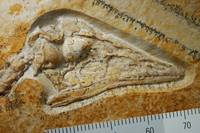
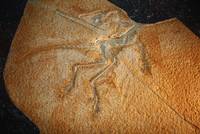
The Archaeopteryx is one of the most famous fossils in the world. It originates from the approximately 150 million year old plate limestones of Bavaria. From the beginning, the great importance of these fossils for evolutionary research was recognized: The animal combines reptile and bird characteristics, thus proving the phylogenetic origin of the birds, whose direct ancestors were predatory dinosaurs of the Earth's Middle Ages. Archaeopteryx has already been honoured many times, e.g. as a motif on a 10-euro coin or on stamps, and is now also named fossil of the year by the Paläontologische Gesellschaft. Fossils like Archaeopteryx show that our science - palaeontology - can never do without well-preserved fossils with unique features to shed light on the history of life.
In the course of 160 years 14 specimens of primeval birds have been found, most of which can be assigned toArchaeopteryx. They all originate from the plate limestones of the Upper Jurassic of the Franconian Alb in the wider surroundings of Eichstätt (the "Solnhofener Plattenkalken"). Each of the specimens contributed to the knowledge about the genus Archaeopteryx, which can now be considered as quite well researched, although new findings are constantly being made. The fossil of the year is represented by the Eichstätt specimen. This smallest Archaeopteryx found is a young animal. At the same time it is one of the best preserved specimens, which has provided important insights into the anatomy of the skull, although the feathers are less distinct than in other specimens. The specimen was found in 1951 and has been one of the highlights of the Jura Museum in Eichstätt since its opening in 1976. It shows the cervical spine typically bent backwards, which can be observed in many fossil skeletons - an overextension that occurred during decomposition due to shrinkage of the cervical tendons.
It is now widely accepted that Archaeopteryx was able to fly and that dinosaurs still survive as birds today. The feathers of the primitive bird were asymmetrical and already constructed in the same way as the flight feathers of modern birds. Similar to some of today's birds of prey, Archaeopteryx had feathered trousers, i.e. feathered legs, as has been shown only recently. Wings, feathers and wishbone make Archaeopteryx a bird, while teeth, the long ossified tail, belly ribs and the claws on the wings refer to its dinosaur nature. He lived as a nimble predator on islands with subtropical climate near the sea troughs between sponge reefs where the plate limestones were deposited. Mostly Archaeopteryx is probably running, hunting for insects or small vertebrates. Short phases of the flight may have been helpful to escape from predators. The claws on the wings show that he was probably a skilled climber.
The Solnhofener Plattenkalke is a site of international importance, a fossil deposit that has handed down hundreds of species in excellent preservation. Plate limestones are of particular importance for vertebrates because skeletons can be preserved completely and in composite form, as well as occasional remains of skin or, in the case of Archaeopteryx feathers, with the finest details. Such good preservation is a great exception and makes the Plattenkalke a unique window to the world of the Upper Jurassic.
All Urvogel specimens were found on the Southern Frankenalb (Bavaria) at the following locations: Langenaltheimer Haardt, Jachenhausen near Riedenburg, Blumenberg, Workerszell and Petershöhe near Eichstätt, Solnhofen, Schamhaupten, Mühlheim as well as Daiting.
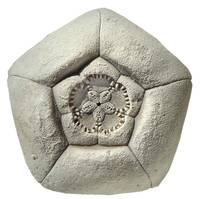
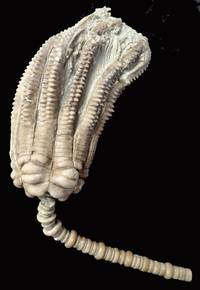
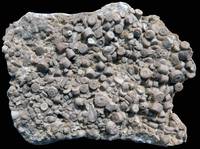
Encrinus liliiformis, the "lily stone" in the literature of the 18th century, is one of the first fossils to have attracted attention in the early period of research. But long before that, their stem members had inspired the imagination to all kinds of interpretations. Thus St. Boniface, concerned about the greed of our ancestors, turned all the money of the Gentiles to stone. Since then, the "Bonifacepfennige" have been lying in the vaults of the Trochitenkalk, explains the pious legend. Elsewhere the Trochites were called witch money, clasp stones or even wheel stones. It was not until the Enlightenment that their true nature was seen as the fossil remains of marine animals related to starfish. And when in the middle of the 18th century the first living sea lilies were lifted from the Caribbean deep sea to the light, one recognized in these "sea palms" today's relatives of the well-known Encrinus. Thus, the Muschelkalk sea lily became an exemplary representative of the crinoids worldwide, even though several thousand species are known today from the rocks of the last 450 million years. Today stalked sea lilies only live in great depths.
We encounter the Muschelkalk-Seelilie not only outside in the field, but in the middle of Berlin, Stuttgart or Munich. And not only in the museum, but everywhere where trochite lime was used for building. Half a millennium ago, the great Georgius Agricola called trochites or wheel stones the sea lily stems that had disintegrated into cylindrical elements. Washed up into trillions, they build up rock banks several metres thick. To find a complete crown of sea lilies, perhaps even with their delicate stems, you need a little luck. But that can be a sign of the future on a hike through the Württemberg Jagst valley near Crailsheim. At least the trochites will be discovered there, and that immediately in masses. The Muschelkalk sea lily was chosen as the fossil of the year because its remains have been known for so long, even if they were only discovered late in life. It is also found almost everywhere where the Upper Muschelkalk is found.
However, Encrinus liliiformis - that is its scientific name - is not a plant, as one might think, but a marine animal from the echinoderms, related to starfish and sea urchins. Like all echinoderms, Encrinus liliiformis had an internal skeleton consisting of thousands of porous calcareous plates held together by connective tissue. A metre-long stalk anchored the animal on oyster beds at the bottom of the Muschelkalk Sea and straightened it up so that it could align its crown with the filigree filter apparatus in the current in order to sift out planktonic food from it. The five-branched symmetry of the echinoderms is best seen in the goblet of the sea lily, which consists of three times five plates and in the middle of which the stem segments are formed: from each ray comes an arm that divides into two arm branches, each with a double row of arm segments to which a multi-branched pinnule is attached. With sticky "feet" the sea lilies collect their food and transport it to the hidden mouth on the goblet cover.
Sea lilies or crinoids, as science calls them, have hardly any predators, but they are endangered if fine mud is stirred up, which paralyses their sensitive respiratory system. This happened about 240 million years ago in the Triassic period, when Central Europe was located in the subtropics, when summery cyclones came in from the southeast from the Tethys Ocean and churned up the bottom of the trochitic limestone sea. Whole populations of sea lilies, starfish and sea urchins then met their end, were embedded by the sinking mud and preserved until today - a Pompeii of the shell limestone. This is famous for such "conserved fossil deposits". Normally, however, the sea lilies decayed after death and their skeletal parts were transformed into calcite crystals. Washed together to form mighty rock banks, they form the trochitic limestone.
Classical sites where Encrinus liliiformis was found, known since the 18th century, were the quarries on the Elm in Lower Saxony and in the vicinity of Hildesheim and Göttingen. In southern Germany, the quarries in the Jagst valley near Crailsheim, where the trochite lime is industrially quarried and processed, or near Neckarwestheim, are still in use today. In recent years, plates of several square metres in size have been excavated in the Weserbergland region of North Hesse, Westphalia and Lower Saxony, on which the sea lilies lie embedded in masses.
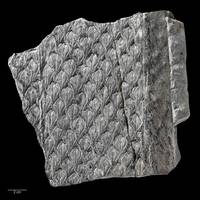
Lepidodendronwas very widespread in Europe and North America about 320 to 300 million years ago. Representatives of this genus can be found on almost every hard coal stockpile. Remains of this extinct fossil plant, which belongs to the lycopod family or lycopsids, are so common that the plant even has a German name: the Scaly Tree. The name refers to the diamond-shaped leaf scars on the surface of the trunks and branches, which are somewhat reminiscent of fish scales. The genus Lepidodendron was chosen as fossil of the year 2018 not only because of its scientific but also because of its historical importance.
The tree-like lycopsids grew in moist to very moist locations. They were dominant in the extensive swamp forests of the Upper Carboniferous. They supplied up to 80 to 90% of the biomass, which was later converted into hard coal. Industrialisation from the middle of the 19th century onwards would not have been possible without hard coal. Even though coal mining is already a closed chapter in many European countries, we must not forget that these plants provided the fuel that fired the industrial revolution. Without the carbonaceous swamp forests, whose biomass stored deep in the earth has been converted into hard coal over time, the Ruhr area would still be a rural region strongly characterised by agriculture. The same applies to many other industrial regions worldwide. Thus, Lepidendron is not only of scientific, but also of historical and indirectly of enormous economic importance.
All of today's lycopods are small herbaceous plants, a few decimetres high, which are also represented in Germany with several, mostly rather rare species. The forms from the Upper Carboniferous looked quite different. They were big trees with thick trunks. The genus Lepidodendron, which was elected Fossil of the Year in place of the tree-like lycopsids, was able to reach a height of over 40 metres.
Tree shaped lycopsids have been known for a very long time. The genera Lepidodendron and Sigillaria were both already described at the beginning of the 19th century on the basis of their stem imprints with leaf scars. Since the individual parts and organs of these plants are almost always found isolated and practically never joined together, they were originally placed in separate genera. Only afterwards could it be reconstructed which parts and organs belong together. Nevertheless, the separate names are still used for, among other things, root systems, stems, debarking stages of stems, leaves, cones and spores. Anatomically preserved remains of peat dolomite nodules have contributed considerably to a better understanding of Upper Carboniferous tree-like lycopsids.
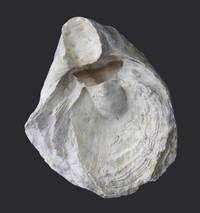
The thick-skinned oyster Pycnodonte (Phygraea) vesiculareis probably one of the most famous writing chalk fossils in Europe. Many people will have seen the oysters, popularly known as "Dickmuscheln", in museums or perhaps even found them themselves during walks on beaches on the Baltic coast (for example on the island of Rügen or Møn) or in North German chalk or sand pits. Our extinct oyster species was chosen as the fossil of the year 2017 due to its high degree of fame and its scientific and scientific-historical importance.
This oyster is one of more than twenty known species of the genus Pycnodonte, which lived in many seas worldwide during the Upper Cretaceous period, about 70 million years ago. Oysters, which belong to the bivalve molluscs (Bivalvia) and molluscs (Mollusca), have been a very successful group of organisms since the Jurassic period in the Mesozoic, even in today's oceans. Due to the different substrates colonized by Pycnodonte (Phygraea) vesiculare, the formation of the shell of this oyster is quite variable. Like all modern and extinct oysters, this year's fossil of the year has uneven shells, which in our species are almost circular to semicircular in shape. The "thick" shell of the left flap is convex and up to 10 centimetres high and can reach a shell thickness of more than 5 centimetres. The smaller right flap on the other hand is flat to concave.
The species name vesiculare is probably due to the blistered or bubble-shaped growth lamellae, which alternate with thin, dense layers in the shell. Our fossil of the year was first scientifically described (as Ostrea vesicularis) in 1806 by the French naturalist and zoologist Jean-Baptiste de Lamarck (1744-1829) using specimens from Upper Cretaceous sediments of France.
The "thick shell" Pycnodonte (Phygraea) vesiculare lived at the bottom of the Cretaceous Sea during the time of the Upper Cretaceous (Cenomanium to Maastrichtium; ca. 100 to 66 million years) and has been found mainly in Europe, but also in West and North Africa, South India and New Caledonia. The distribution area of this oyster is therefore not regionally limited, but rather very wide, which explains the frequency and the high degree of popularity of this fossil oyster.
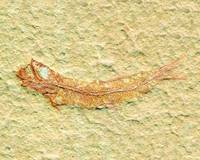
About 150 million years ago a large number of swarms of the small prey fish populated spattiform leptolepides the marine waters around the Solnhofen lagoon areas. Many will have seen the small fish, affectionately called "Spratti" by collectors, in museums with exhibitions on the Southern German Plattenkalken. This extinct fish species was chosen as the fossil of the year 2016 due to its high degree of fame and its scientific and scientific-historical importance.
This small sprat-like fish (lat. "sprat-like tender scaler") is one of two species of the genus Leptolepides, which occurred frequently in the marine waters of the southern Frankenalb during the Upper Jurassic period, about 150 million years ago. they already belonged to the real bone-fish (Teleostei), even if still to the rather more primitive forms, at the basis of the tribal-historical development of this fish-group. Their vertebral bodies were already completely ossified and their scales, so-called tender round scales (cycloid scales), no longer showed a layer of enamel. They owe their species name sprattiformis to the similarity with today's sprattiformis, due to the long, slender body shape, the narrow head and the dorsal fin located approximately in the middle of the body. They reached a maximum body length of up to 10 cm, but the average length was between 4 and 7 cm. The "sprat" was described for the first time in 1818 by the French zoologist and anatomist Ducrotay de Blainville under the name Clupea sprattiformis, even though the first illustrations of this fish, which is to be described as a character fossil for the Plattenkalk, already found their way into literature in the 17th century. In the following decades the species was placed into the genus Leptolepis, before finally in 1974 the new genus Leptolepides was established by a Swedish ichthyologist and the species sprattiformis was assigned to it.
As many fossil finds of the "Jurassic Sea Sprat" show, these fish have often appeared in shoals, in order to have greater protection from predatory fish, such as Aspidorhynchus and Caturus, or even marine reptiles, which also live in the Solnhofen subarchipelago, since their small size has served as a food source for larger animals.
This is proven, among other things, by the fact that in many coproliths (petrified excrements) bones and vertebrae of Leptolepides sprattiformis can be detected. These "sprats" have also been preserved as prey in some intestinal remains of large predatory fish and squid as well as some pterosaurs. The latest scientific findings have shown that the fossil swarm lore probably originated from the fact that the fish, due to their swarm escape behaviour, got caught in floating microbial mats, which then became a deadly trap for them. Due to their increasing weight, these finally sank to the lagoon floor together with their contents and could be petrified there.
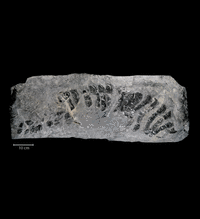
Arthropleura - a giant in the history of the earth! With a length of up to 2.50 metres, Arthropleura armata is the largest arthropod ever to inhabit the land. The species lived about 330 to 290 million years ago, and the first fossils were discovered very early, more than 160 years ago. This extinct animal was chosen as the fossil of the year 2015 because of its scientific and historical significance.
When Hermann von Meyer introduced the name Arthropleura armata in a letter to Professor Bronn in 1853 and described the fossils named after it together with Hermann Jordan almost a year later, the authors only had fragments of a peculiar arthropod from the Upper Carboniferous of the Saarland, which they interpreted as "body rings of a larger crust", a crustacean. Although more complete armour parts and isolated extremities were soon found in almost all coal-mining areas of Europe, the appearance of arthropleura and its systematic position were long unclear. The discovery of an almost complete animal of about 90 cm length in 1935 in the Maybach pit in Saarland was therefore particularly significant. However, this also lacked head and tail ends, so that only an approximate reconstruction was possible. Isolated finds of tanks and extremities, which are more than twice as large as those of the Maybach specimen, as well as tracks up to 40 cm wide, show that the animals reached a length of up to 2.50 m! This makes Arthropleura the largest arthropod ever to inhabit land, a giant in the history of the earth. In recent years more and more contiguous parts of the abdominal side (Freital in Saxony) and from the head area (Saarland) have been found. Not yet known are the antennae, the eyes and the mouth parts. Clear evidence of this animal extends from the late Lower Carboniferous to the Lower Red Period of Europe and North America and thus over a period of about 330 to 290 million years ago.
As the body finds from the present, especially from the Visé of Chemnitz, the Saar Carboniferous and from the Unterrotliegend in the Thuringian Forest show and as the tracks in Scotland, from Nova Scotia in Canada and in New Mexico (USA) clearly prove, Arthropleura lived preferentially in riverine landscapes with loose vegetation, mostly dominated by horsetail trees (calamites).
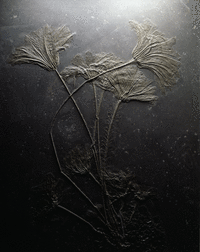
It lived more than 185 million years ago and reached sizes of almost 20 meters. Many people know them from the Posidonia slate of southern Germany or large museums: the Giant Sea Lily subangular Seirocrinus also known as "Swabian Medusa Head" or "Caput Medusæ". As the board of the Palaeontological Society in Frankfurt/M. announced at the beginning of the year, this extinct species was chosen as the fossil of the year 2014 due to its high profile and its scientific and historical importance.
Contrary to what the name might suggest at first glance, sea lilies are not plants at all, but animals that belong to the marine echinoderms and are related to sea urchins and starfish. The (inner) skeleton of the sea lilies is made up of thousands and thousands of individual elements made of lime, which are held together by connective tissue fibres.
Sea lilies, also known as crinoids, first appeared in the earth's history in the early Palaeozoic period about 480 million years ago, and were anchored with long stems in or on the sea floor. Their crowns, consisting of a goblet and at least 5 arms, were mostly aligned against the water currents in the water, with their help they could catch plankton as food. In the entire Palaeozoic period, until 250 million years ago, such stalked sea lilies were very common in the oceans and often formed entire "underwater forests". However, only a few of these crinoids lived to see the beginning of the Earth's Middle Ages; with decreasing diversity and partially changed habitats, new species with greatly reduced stems appeared, many of which were also able to swim actively. Today, only less than 200 species of stalked sea lilies are known to exist exclusively in deep water areas.
Seirocrinus subangularis - the fossil of the year 2014, on the other hand, was characterized by a special way of life - the larvae of this sea lily colonized driftwoods on which (depending on the size of the trunk) more or less large colonies could develop as the animals grew. In this way, the sea lilies could drift with the current - a special way of life called pseudoplanktonic. Seirocrinus was characterized by several special features, one of which was an extremely elongated and very flexible stem, which allowed lengths of over 15 meters to be achieved. The calyxes and crowns of these sea lilies were also greatly enlarged in diameter (sometimes >1 meter), with up to 20 main arms, which were also finely branched. Due to this combination of characteristics, the Seirocrinus crowns functioned as a kind of trawl net for the passive capture of plankton during "drifting".
Especially excellently preserved colonies of Seirocrinus are known from bituminous black shales of Southern Germany (e.g. Ohmden near Boll or Holzmaden, Württemberg), and England; further finds have recently been made in Canada and Japan.
The original exhibit, on which the scientific description of the species is based, has been in Göttingen since 1827; today it is part of the collections of the Geosciences Museum of the University and is also open to the public in the exhibition. The "fossil of the year 2014" became famous when 290 years ago, in 1724, it was described in detail as Caput Medusæ or Medusa head by the Stuttgart court preacher and doctor of theology, Eberhard Friedrich Hiemer. Hiemer compared his find of Ohmden near Boll, which measures a good 1 square metre, with recently published modern echinoderms from the Arctic Sea and explained that the reason for the Württemberg occurrence of this fossil lay in the "flood whose gush seemed to him to be large enough to bridge any distance" described in the Bible. Hiemer received several honours for his excellent description of Seirocrinus; his copperplate engraving published in 1724 was also "copied" several times and reproduced in famous works. For example in the "Copper Bible" by the Swiss naturalist Johann Jakob Scheuchzer (1731), or the "Stone Kingdom" by Johann Ernst Immanuel Walch (1762), as well as in the German translation of Carl von Linné's "Natural System of the Mineral Kingdom" (1779).
In addition to the original plate exhibited in Göttingen, which has survived all the turmoil of time unscathed until today, other outstanding pieces of the fossil of the year 2014 are on display in other natural history or palaeontological museums. These include the Hauff Primeval World Museum in Holzmaden (www.urweltmuseum.de), the Berlin Natural History Museum (www.naturkundemuseum-berlin.de) and the Palaeontological Collection at the University of Tübingen.
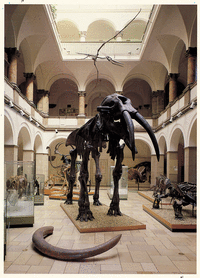
At the annual conference for the 100th anniversary of the Paläontologische Gesellschaft in Berlin from 26 to 28.9.2012, the Gomphotherium by Gweng from the Bavarian State Collection of Palaeontology and Geology in Munich was awarded the Prize Fossil of the Year 2013.
The skeleton of the Gomphotherium of Gweng (Mühldorf, Bavaria) has formed the majestic centre of the Palaeontological Museum in Munich for over 30 years. This colossal primeval elephant with four tusks and an imposing size of three metres shoulder height and five metres body length lived in Central Europe ten million years ago. The skeleton impressively represents not only the subtropical fauna that was at home in Europe until five million years ago, but also the former diversity of proboscideans, which were almost globally distributed until the Ice Age and of which today only the Asian and African elephants remain. The discovery of the Gomphotherium of Gweng in 1971 is still a paleontological sensation today. It still represents one of the extremely rare finds of pre-glacial proboscidean skeletons worldwide. His rescue from the bed of the Inn was a logistical and preparative masterpiece. The 170 preserved individual bones form unique comparative material for any aspect of research into the evolution of the elephant's skeleton. The original bones and teeth are kept in the collection rooms of the Bavarian State Collection of Palaeontology and Geology in order to be available for research by scientists at all times. Casts of the skeleton can be viewed in Munich, the Senckenberg Naturmuseum Frankfurt, the Naturhistorisches Museum Basel and in Japan at the City Museum Sendai. Only once a year, on Open Day, the Palaeontological Museum opens its doors, otherwise closed to the public, to allow a glimpse of the original bones of the Gomphotherium of Gweng.
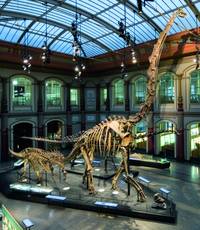
From Brachiosaurus brancai several partial skeletons and an extraordinarily well preserved and complete skull were recovered from sedimentary rocks about 150 million years old in the area of Tendaguru Hill. The large number of well-preserved bones makes this species the largest dinosaur ever so completely documented. The bones of the brachiosaurus used for the famous skeletal reconstruction in the Museum für Naturkunde Berlin were already found in 1909 and have formed the core of the museum's exhibitions since 1937. After decades of erecting the skeleton with reptilian splayed limbs, the skeleton was reassembled in 2005 with the legs standing straight under the body and a far more dynamic posture. With its 13.27 m height (the neck alone is more than 9 m long) it is the world's tallest mounted dinosaur skeleton and amazes visitors and scientists alike. Brachiosaurus brancai belongs to the group of sauropods, giant herbivorous long-necked dinosaurs, which are the largest land animals that have ever lived on earth. In contrast to other sauropods, however, it has a unique "giraffe-like" stature: the front legs are longer in relation to the hind legs, the withers are hump-like raised in the front part of the trunk and the neck is probably almost vertical. Thanks to an ingenious lightweight construction with air sacs to support breathing and a complicated system of clasps and cavities on the vertebrae, the weight of the animal was manageable despite its gigantic size: currently it is estimated to be "only" 26 tons.
The remains of this gigantic dinosaur were discovered during the legendary German Tendaguru expedition, which is still considered one of the largest and most successful vertebrate palaeontological expeditions of all time. Between 1909 and 1913, one of the largest dinosaur deposits in the world was excavated in the then colony of German East Africa not far from the city of Lindi in present-day Tanzania. A total of 235 tons of dinosaur bones were recovered and brought to Berlin. Up to 500 local workers took part in the excavation activities at the same time.
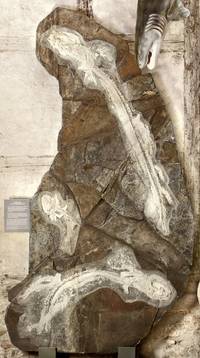
The 1.72 m wide and 3.06 m high fossil record shows three skeletons of the xenacanthic freshwater shark from the Rotliegend of the Saar Palatinate (Meisenheim Formation, M 6, Permian; according to Heidtke 2007). It was excavated by an excavation team led by Arnulf and Harald Stapf from the Palaeontological Museum Nierstein near Niederkirchen in about 30 single plates and was prepared by Georg Sommer with the compressed air preparation graver at the Natural History Museum Schleusingen for almost 1.5 years since 2007.
The three skeletons belong to the shark family Xenacanthidae, which was widely distributed during the Rotliegend period about 290 million years ago and is considered extinct since the Upper Triassic. The free back-sting (dorsal-sting), the low, long-lasting back-fin (dorsalis) and the peculiar shape of tail (caudalis) and anal fins are conspicuous. Also the shape of the teeth with two strong lateral tips and a much smaller central tip is characteristic for xenacanthid sharks (Heidtke 1999, Schneider & Zajic 1994). The calcified cartilage substance of the sharks from the Niederkirchen site is coloured white ("white sharks") due to high temperature of a nearby magmatic body through apatite sprouting.
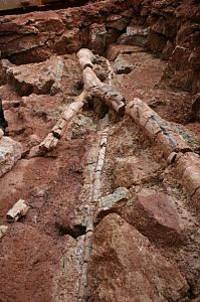
The horsetail tree from the Permian was buried by a volcanic eruption about 290 million years ago. It was discovered during excavations in the Chemnitz-Hilbersdorf district in 2008 and exposed over a length of 10 metres by the end of October 2009. The giant horsetail is multi-branched. It is therefore of particular importance for palaeobotany: it refutes the previous assumption that these plants were only unbranched in the Permian.
The excavations in Chemnitz-Hilbersdorf are to continue until September 2010. So far, more than 300 fossil plants have been exposed, including the giant horsetail Arthropitys bistriata who was named Fossil of the Year 2010.
The giant horsetail is also very common in Germany. Although it is related to the fossil giant horsetail, they are two completely different species. The growth height of the recent giant horsetail is 1 - 2 m. This makes it the largest horsetail within the Central European flora. In the description of the biotopes and geotopes protected under § 20 LNatG M-V in the forest and its surroundings, it is mentioned in the vegetation of the source area. Its distribution in Mecklenburg-Vorpommern is limited to a few occurrences. In the district of Müritz, the giant horsetail is proven in the NSG "Hellgrund".
Fossil finds of the giant horsetail are not to be expected due to the history of the landscape in our federal state. As boulders from this period, mainly volcanites, such as rhombic porphyry and Oslo-gnimbrite, can be found.
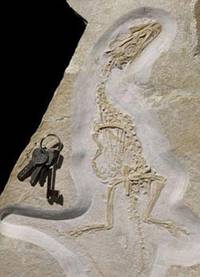
It was a find of the century: the best-preserved, carnivorous dinosaur (Theropode) ever found in Europe comes from Jurassic plate limestones of the Altmühltal region. The new dinosaur genus received the name Juravenator - Jura hunters.
Juravenator joins the numerous theropods that have become known in recent years from the Lower Cretaceous of China, which have virtually revolutionized our image of the appearance of dinosaurs. The find from the Frankenalb can definitely stand up to these Cretaceous finds from China. It even shows mineralized remains of the soft tissues such as scaling of the skin in the tail area.
Due to its outstanding scientific importance, this optically attractive fossil has now been elected Fossil of the Year 2009 by the Paläontologische Gesellschaft. Juravenator is - after the largest ammonite in the world, which is exhibited in the Museum für Naturkunde in Münster - the second fossil to be awarded this title.
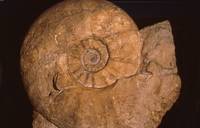
In 1887, an ammonite with a diameter of 1.36 metres was surprisingly discovered in a quarry near Seppenrade (Coesfeld district) in the southern Münsterland, about 25 kilometres south-west of Münster. Prof. Dr. Hermann Landois, director and founder of the then Westphalian Provincial Museum of Natural History and "Director of the zoological section of the Westphalian Provincial Association for Science and Art" in Münster believed that the largest ammonite in the world was now located in Westphalia.
The petrifaction caused quite a stir in the professional world - until 23 February 1895, when Landois received a telegram from the merchant, zoologist and local historian Theodor Nopto: "Seppenrade. Second giant ammonite found. Diameter 1.80 m. Nopto." In fact, another specimen had been found in the same quarry where the first giant had been discovered.
The new find is still the largest that has been found worldwide. Landois described the new find and gave it the scientific name Pachydiscus seppenradensis. Later editors placed the fossil in the genus Parapuzosia, so that today Parapuzosia seppenradensis is called.
During the recovery the fossil broke into seven parts, which were later reassembled. Landois acquired the ammonite for 125 Goldmark for the Provinzialmuseum and had it transferred to Münster on March 8, 1895 and set up in the old building of the Museum of Natural History on Himmelreichallee. In December 1980 the giant ammonite was transported from the old to the new natural history museum of the Landschaftsverband Westfalen-Lippe (LWL).
Paläontologische Gesellschaft
Geschäftsstelle
Schumannstr. 144
63069 Offenbach am Main
Tel.: 069 / 403 585 77
Fax: 069 / 403 560 26
Email: geschaeftsstelle(at)palges.de
Internet: www.palges.de
Newsletter bestellen
Mitglied werden
Unsere Datenschutzerklärung